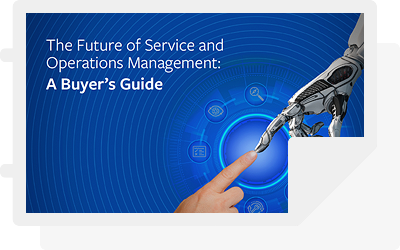The future of service and operations management is here now and is crucial to control the chaos of hybrid IT. Innovations in service and operations management are emerging as an imperative from the service desk to the boardroom for enterprises to achieve faster time-to-market; increase productivity, efficiency, and quality of service. In a landscape that seems to evolve on a daily basis, successful digital leaders know that aligning IT service and operations management is the key to growing at the scale required to compete and thrive. Industry leading enterprises are embracing this convergence to drive a service experience that delivers service delivery excellence, empowers line-of-business users, and increases business agility.
Instead of treating each as silos, there are immediate benefits realized with a converged end-to-end service and operations management system:
- Faster time-to-market for delivery of quality, differentiating, services
- Faster resolution of service issues and operational events to increase service quality
- Increased IT staff efficiency enabling focus on strategic initiatives
- Automated resolution of routine issues freeing up service desks to focus on issues that impact productivity & efficiency
- Reduced risk of security vulnerabilities
- Increased business agility
- Reduced CapEx
Not only does integration break down silos, it helps you connect the dots across your ecosystem turning your unknowns into knowns. Let’s explore how you can take advantage of these benefits by first understanding best practices and critical capabilities required as you evaluate adopting a converged ITSM / ITOM environment.
Industry leading service and operations management tools should:
- Integrate and automate all key processes including incident, problem, change, release and SLA management to uncover events, alerts and anomalies in real time.
- Apply AI and machine learning across operations management (AIOps), service management and user environments to accelerate resolution of requests and trouble tickets, as well as automated event remediation.
- Provide a flexible and streamlined user experience for self-service and request fulfillment.
- Support non-IT business use cases such as finance and CRM.
- Understand infrastructure trends and adjust automation to match.
- Enable scalability beyond the data center.
- Deliver seamless operational support of enterprise services across multi-cloud environments.
- Increase visibility and control with end-to-end integration of data, management tools and platforms including service and operational dependencies, performance and utilization.
- Reduce risk and cost through intelligent control of services and infrastructure.
- Provide a unified view of cost and performance metrics for all service delivery and IT operations to ensure cost-effective and efficient use of resources.
Learn more about how your enterprise can leverage convergence of service and operations management to increase service efficiency, quality, speed and business agility while reducing costs. Download The Future of Service and Operations Management: A Buyer’s Guide to learn:
- For IT operations managers, it’s meeting strategic goals for service delivery excellence through automated tools and information that reduce manual workload and use human intervention where it adds the most value rather than responding to alerts and requests.
- For line-of-business users, it’s access to the services and information they need to help themselves, quickly and simply. The right action at the right time, with the least friction, through powerful user portals, intelligent automation and easy-to-use service catalogs.
- For the enterprise as a whole, it’s enhancing the ability to empower users across the organization through digital transformation that’s powerful, efficient and effective.







